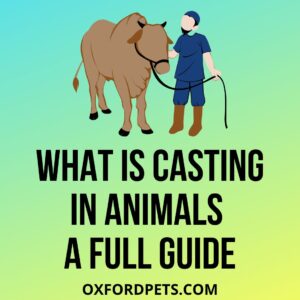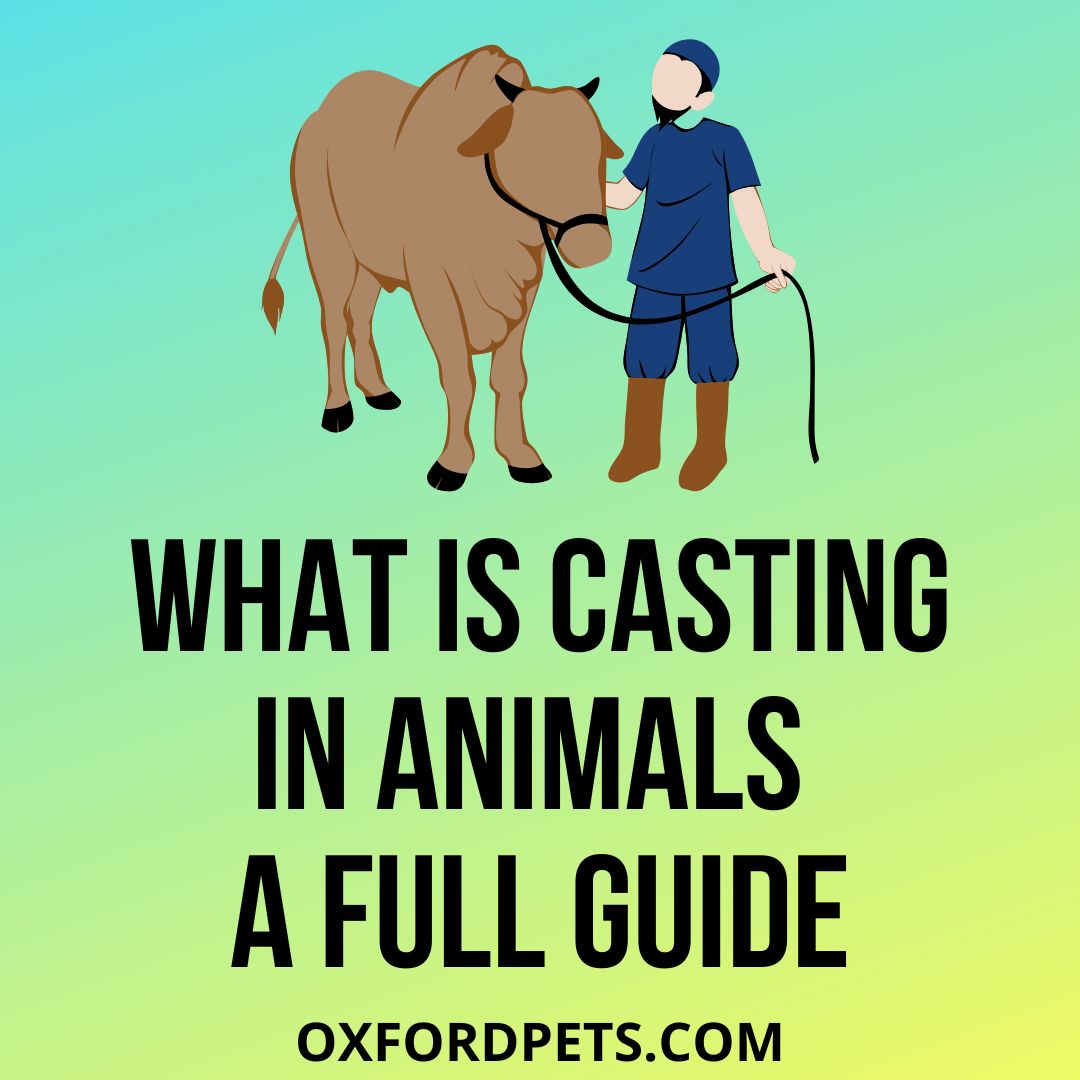The Casting of Animals like cows and buffaloes is extremely important in order to manage a cattle farm rightfully. What makes Animal Casting necessary? Well, a range of reasons, including Hoof cutting, Vaccinating, Tagging, Shoeing, Surgery, Branding, Calving Assistance, Castration, and much more.
Want to learn more about Animal Casting? Continue reading till the end and learn some of the most useful information.
Contents
What Is Casting In Animals?
Casting in Animals basically refers to a technique that involves using a rope and tying it firmly around cattle’s bodies in order to control them. Rope casting is often used in adult cattle to make them lie down or become recumbent without much struggle. The rope applies consistent pressure to different points of the cattle’s body, especially on muscles and nerves. Casting In Animals, though, isn’t inhumane but an absolutely safe practice.

What Are The Types Of Casting?
Casting in Animals isn’t limited to one single technique, but it involves many. Several people even confuse between Casting of cattle and the Restraining of cattle; however, both are two different processes. They may involve a few similar practices, but still, there are some differences between these two terminologies.
Here are the different Methods of Casting animals and how they function.
Reuff’s Method of Casting
Reuff’s is undoubtedly the most common method of casting followed across the world. Used by many professionals, Reuff’s method involves the usage of a non-slip knot that ensures that the rope around the neck would not tighten.
For using Reuff’s Method of Casting:
- Gather at least three individuals and a 10 m-long nylon rope.
- Before you begin, make sure the Casting area is clean and layered with soft material that would minimalize the stress on the Animal.
- All you need to do is, separate the Cattle (Cow or Buffalo/bison) from its herd and take it to the casting area.
- Next, hold the cattle’s neck with a halter and tie it to a pole/ wooden log keeping it closer to the ground. Doing so will ensure no pressure is created on the cattle’s neck while casting.
- Now take one end of the rope and tie it rightfully around the cattle’s neck. The knot should be secure and tight enough not to slip away yet loose enough so that it doesn’t chock the Animal.
- Further, make a half hitch near the heart right behind the withers. You can form the hitcher by making a U- Shape on one side by folding the rope, and then while maintaining the shape, pass the free end of the rope to another side. Following that, take the side of a U-Shape from beneath and then interlock the free end with a U-Shape. This interlocking step is necessary to make a secure Hitch.
- Make another hitch at the abdomen area in front of the cattle’s hip bone. Here make sure the hitch shouldn’t touch the udder.
- Next, pass the through flank behind the hind legs. Here two individuals must be required to pull back the rope so that the cattle come into a recumbent position.
- Now let one individual push the recumbent position cattle simply to lay down on the ground, preferably on its right side.
- Once the Casting is done, free the Animal.
Burley or Criss-cross Method of Casting
Burley or Criss-cross Method of Casting is quite similar to Reuff’s Method. For utilizing the Burley Method, firstly, separate the cattle from its herd and tie its neck to a pole so that none of the rope’s stress troubles him/her. The process until here is as similar to Reuff’s Method.
- Now, one individual must control the animal head by handling the rope halter.
- Another two individuals should involve in handling the 10 m casting rope. Here, simply bend the 10 m long rope from the middle and make it half-half.
- Now place the middle of the rope on the top of the neck of the cattle and bring the two ends beneath the forelegs to make a cross below the Brisket.
- Next, take two ends of the rope up and cross them on the back near the loin region. Simultaneously, take two ends of the rope down, pass them through flanks, and take them out from behind the hind legs.
- Lastly, using a little force, pull back the ends of the rope, and the cattle will fall to the ground. Once everything is done, free the pressure.
Besides the popular Reuff’s and Burley or Criss-cross Methods of Casting, the three other practices involve:
- Indian Method of Casting
- Country Method of Casting
- Rope Squeeze Method of Casting
However, across the world, as per expert animal handlers, Reuff’s and Burley’s methods are more successful.
Reuff’s Vs Burley or Criss-cross Comparison
Which is better: Reuff’s Method of Animal Casting or Burley or Criss-cross Method of Animal Casting?
Though both methods of Casting are professional and successful, many farm owners swear by Burley’s method when it comes to comparison. Burley or Criss-cross Method involves no knot, and therefore the cattle can be freed simply by pulling the pressure at the two ends.
However, Reuff’s Method involves several knots and after Casting is over, freeing the Animal becomes slightly tricky. Also, Burley or Criss-cross Method involves only two pressure points and is quite easy to understand.
Whereas Ruff’s Method involves three pressure points, understanding the entire procedure can be difficult for some.
Precautions In The Casting Of Animals
The Casting of animals is a safe process though still, one must follow a set of precautions, especially for ensuring cattle’s comfort. For example:
- Always choose a rope 10 to 12 m long.
- The casting rope should be strong, preferably made up of jute, but at the same time, ensure it is soft.
- Before casting the Animal, it is better to fast him/her for 12 hours. It will help in making the Animal comfortable since the process will involve lying down, on the side, and more.
- Avoid casting animals who are sick, injured, or pregnant.
- The Casting area should be free from glass and pebbles, soft, comfortable, and well-labeled.
- Regardless of whichever method of Casting you are involved in, the Animal must not get hurt.
- Despite the casting method, the rope should never create pressure on any point of animals’ bodies.
- The Animal must not be made to lie longer on the ground, or it may lead to bloating.
- The Casting of Animals isn’t the job of one individual since controlling the cattle can be difficult. It would require 3 to 4 individuals for ease of the process.
- Once the Casting is done, the Animal should be groomed nicely.
- When releasing the rope at the end of the process, it should be slow and gentle.
Frequently Asked Questions
How Do You Lay A Cow Down?
For laying down a cow while casting, simply pull the ends of the rope with slight pressure, and the cow will fall to the ground. Though make sure while the cow falls, the head should face the opposite direction of falling.
How Do You Tie A Cow With A Rope?
For tying a cow with a rope (cow hitch knot), follow the step-by-step process given below:
All you will need is a single length of rope and a pole to hitch with.
- Firstly, wrap one end of the rope around the pole from the back towards the front.
- Next, pass the end under the remaining rope. Here you need to bring the rope straight up.
- Now wrap the end of the rope again around the pole but from the front towards the back.
- Further, pull the end of the rope straight from the loop that you have just created. Keeping pulling the rope to tighten the knot.
Why do we cast cows?
Casting a cow is basically done for different reasons, including surgery, vaccination, hoof cutting, and more. Since general anesthesia is quite risky for adult cattle, Casting helps quite a lot.
How long does it take for a cow to have a cast?
It can easily take a few hours for a cow to have a cast. Since adult cows are quite big, the process takes a long. Besides cattle’s size, there could be a range of other problems as well. The major problem is when one tries to bring the cow into the right position, it could really take a lot of time.
Wrapping up…
For managing a farm or different activities with the cattle, the Casting of Animals is quite necessary. Though no matter what method you choose, you must always ensure animals’ comfort at the most.
